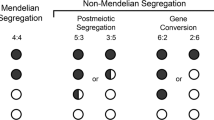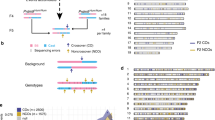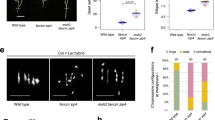Abstract
We show here that recombination occurs at the normal rate in compound female mice containing two different complementing lethal haplotypes (th17/tw12 where there is a long stretch of homologous t-mutant chromatin. Thus the recombination suppression of a complete t-haplotype cannot be due to an intrinsic factor(s) which suppresses along the length of its own chromosome but is due to ‘mismatching’ of wild-type and mutant chromatin. Naturally occurring t-haplotypes of mouse chromosome 17 have several interesting genetic properties. First, they are always transmitted from males in much higher proportions than mendelian expectation; presumably this accounts for the maintenance of lethal and semilethal t-haplotypes at polymorphic levels in populations of wild mice, t-Haplotypes also show recombination suppression. The conventional map distance between genetic markers T and tf is 7–12 cM, whereas in (t/+) heterozygotes for naturally occurring t-haplotypes, recombination is suppressed and T and tf seem to be separated by only 0.1–0.5 cM (ref. 1). The region of recombination suppression extends to and includes the major histocompatibility complex (H–2)2. Thus t and H–2 effectively travel as a single unit— a ‘super gene’3. Although recombination suppression is known to be accompanied by failure of chiasmata formation4, the mechanism underlying the suppression has remained an enigma. Lyon suggested a disorder of t-heterochromatin5 and more recently a change in ‘intercalary’ middle repetitive DNA6. She proposed that either t-chromatin is intrinsically incapable of participating in crossing-over, or chiasma formation is prevented because of mismatching and mispairing of normal and abnormal chromatin. We have measured recombination between two chromosomes which carried extensive overlapping segments of t-chromatin. We report here that in this configuration, recombination occurs at a normal rate, and thus we conclude that cross-over suppression is due to mismatching.
This is a preview of subscription content, access via your institution
Access options
Subscribe to this journal
Receive 51 print issues and online access
$199.00 per year
only $3.90 per issue
Buy this article
- Purchase on Springer Link
- Instant access to full article PDF
Prices may be subject to local taxes which are calculated during checkout
Similar content being viewed by others
References
Bennet, D., Dunn L. C. & Artzt, K. Genetics 83, 361–372 (1976).
Hammerberg, C. & Klein, J. Genet. Res. 26, 203–211 (1975).
Snell, G. Folia biol., Prague, 14, 335–358 (1968).
Forejt, J. Folia biol., Prague, 18, 161–170 (1972).
Lyon, M. F. & Meredith, R. Heredity 19, 301–339 (1964).
Lyon, M. F., Evans, E. P., Jarvis, S. E. & Sayers, I. Nature 279, 38–42 (1979).
Bennett, D., Artzt, K., Cookingham, J. & Calo, C. Genet. Res. 33, 269–277 (1979).
Lyon, M. F. & Bechtol, K. B. Genet. Res. 30, 63–76 (1977).
Silver, L. M., White, M. & Artzt, K. Proc. natn. Acad. Sci. U.S.A. 77, 6077–6080 (1980).
Lyon, M. F. & Mason, I. Genet. Res. 29, 255–266 (1977).
Dunn, L. C., Bennett, D. & Cookingham, J. J. Mammal. 54, 822–830 (1973).
Author information
Authors and Affiliations
Rights and permissions
About this article
Cite this article
Silver, L., Artzt, K. Recombination suppression of mouse t-haplotypes due to chromatin mismatching. Nature 290, 68–70 (1981). https://doi.org/10.1038/290068a0
Received:
Accepted:
Published:
Issue Date:
DOI: https://doi.org/10.1038/290068a0
This article is cited by
-
Meiotic drive in house mice: mechanisms, consequences, and insights for human biology
Chromosome Research (2022)
-
The cld mutation: narrowing the critical chromosomal region and selecting candidate genes
Mammalian Genome (2006)
-
A Robertsonian translocation suppresses a somatic recombination pathway to loss of heterozygosity
Nature Genetics (2003)
-
Limits of the distal inversion in the t complex of the house mouse: Evidence from linkage disequilibria
Mammalian Genome (1991)
-
A long story and a short tail
Nature (1990)
Comments
By submitting a comment you agree to abide by our Terms and Community Guidelines. If you find something abusive or that does not comply with our terms or guidelines please flag it as inappropriate.



